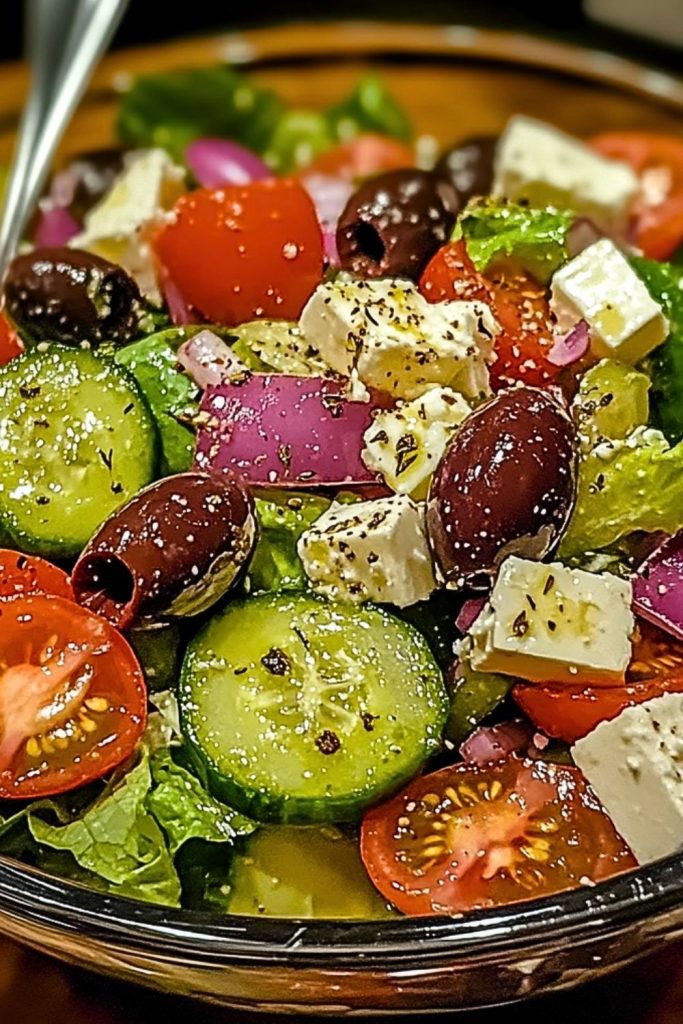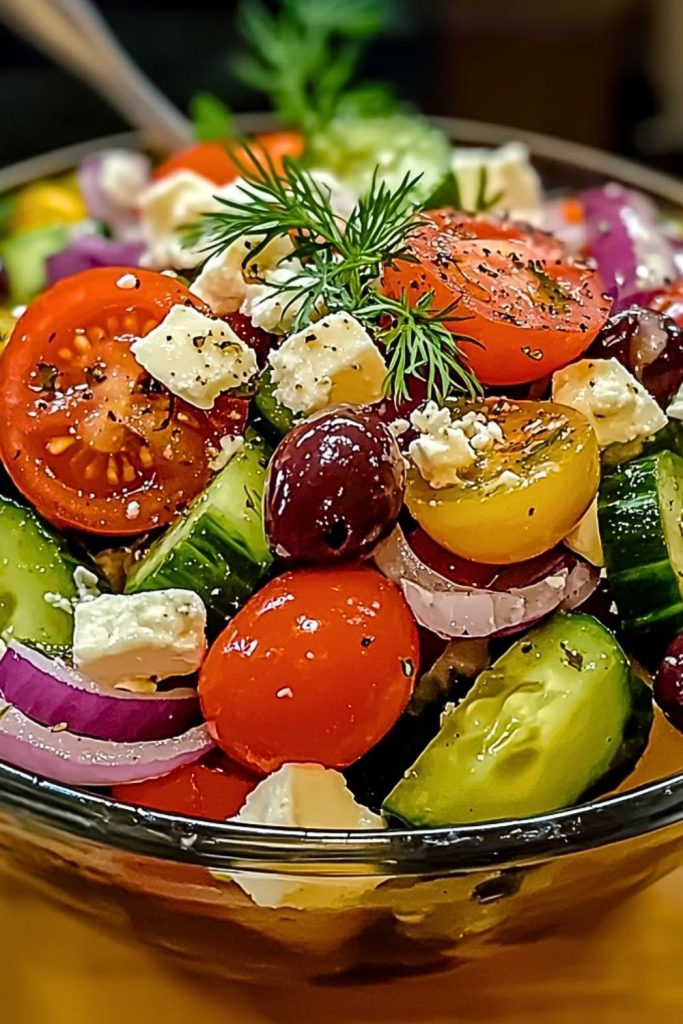There’s something timeless and utterly refreshing about a bowl of Classic Greek Salad. I’ve made this countless times — on hot summer days when the stove is an enemy, or as a vibrant side that always steals the show. The colors alone — crimson tomatoes, emerald cucumbers, purple onions, snowy feta — are enough to make you hungry. But it’s the flavor that makes this salad unforgettable: crisp vegetables, briny olives, and that glorious splash of olive oil and oregano tying it all together.

I love how this salad doesn’t pretend to be anything fancy. It’s rustic and honest — a dish built on fresh, simple ingredients that shine with every bite. No creamy dressings or hidden sugars; just bold Mediterranean flavors doing their job beautifully. If you’re looking to impress at a barbecue, contribute to a potluck, or just treat yourself to something wholesome, this Greek salad never fails.
Why You’ll Love This Classic Greek Salad
- Refreshing and Light: Packed with crunchy veggies and juicy tomatoes, it’s the ultimate no-cook dish for warm weather.
- Full of Flavor: The combination of briny olives, sharp onion, creamy feta, and oregano delivers a punch of flavor.
- Easy to Make: Comes together in 10 minutes flat. No cooking, no stress.
- Versatile: Great as a side or as a main dish with grilled chicken or shrimp.
- Naturally Healthy: It’s low in carbs, gluten-free, and rich in nutrients.
What Kind of Feta Cheese Should I Use?
When it comes to Greek salad, not all feta is created equal. I always opt for a block of feta cheese packed in brine — it’s creamier, tangier, and more authentic than the pre-crumbled versions. The brine keeps the cheese moist and flavorful, which makes a noticeable difference in the final dish.
If you can find Greek feta made with sheep’s milk or a blend of sheep’s and goat’s milk, go for it. It offers a richer taste and slightly crumbly texture that pairs beautifully with the salad’s other bold elements. Avoid dry, rubbery crumbles from plastic tubs — they just don’t do this salad justice.
Options for Substitutions
Sometimes you don’t have everything on hand, and that’s okay. This salad can still shine with a few smart swaps:
- Feta Cheese: Swap with goat cheese or a vegan feta-style alternative for a dairy-free version.
- Kalamata Olives: Use black olives in a pinch, though you’ll miss a bit of that signature Greek brininess.
- Red Onion: Shallots or sweet onions can be gentler substitutes if raw onion is too strong for your taste.
- Cherry Tomatoes: Any ripe tomato will work. Just chop it into bite-sized pieces.
- Cucumbers: English cucumbers are great for fewer seeds, but regular ones work too — just peel if the skin is tough.
- Romaine Lettuce: While not always traditional, it adds crunch and bulk. You can use arugula, spinach, or omit entirely for a classic Horiatiki style.
Ingredients for This Classic Greek Salad
Each ingredient in this salad plays a vital role — both in flavor and texture. Here’s what goes in and why it matters:
- Cherry Tomatoes
Bursting with sweetness and color, they bring a juicy contrast to the briny and crisp elements. - Cucumber
Cool and refreshing, cucumber adds crunch and balances the stronger flavors in the salad. - Red Onion
Its sharpness cuts through the richness of the feta and the olives, adding a zesty bite. - Kalamata Olives
These briny gems are a hallmark of Greek cuisine, offering depth and a pop of saltiness. - Feta Cheese (Block in Brine)
Creamy and tangy, feta is the star. Its savory flavor melts just slightly into the olive oil and coats the vegetables beautifully. - Romaine Lettuce (optional)
Not traditionally part of Greek salad, but adds bulk and crunch if you’re serving it as a main dish. - Extra Virgin Olive Oil
This ties everything together with its rich, peppery finish. A must for authentic flavor. - Dried Oregano
A sprinkle of oregano adds that unmistakable Mediterranean aroma and sharp herbal note. - Salt and Freshly Ground Black Pepper
Simple but essential, they enhance and balance all the flavors in the bowl.

Step 1: Prep the Vegetables
Start by rinsing your cherry tomatoes, cucumber, and lettuce (if using). Slice the cherry tomatoes in halves, cut the cucumber into thick rounds (and halve those if preferred), and chop the lettuce into bite-sized ribbons. Thinly slice the red onion — a mandoline works great if you want paper-thin slivers.
Step 2: Assemble the Base
In a large salad bowl, combine the chopped romaine (if using), cucumber slices, halved cherry tomatoes, and red onion. This forms the fresh, crisp base of your salad.
Step 3: Add the Olives and Feta
Scatter the Kalamata olives over the veggies. Then, take your block of feta and cut it into hearty cubes. Gently place them over the salad so they stay intact and visible — they should be a proud centerpiece, not buried under greens.
Step 4: Dress the Salad
Drizzle everything generously with extra virgin olive oil. Sprinkle with dried oregano, salt, and freshly ground black pepper. Toss gently if using romaine, or leave untouched for a traditional presentation.
Step 5: Final Touch
Taste and adjust seasoning if needed. Sometimes a little extra oregano or a crack of black pepper brings it to perfection. Serve immediately or let sit for a few minutes to allow the flavors to mingle.
How Long to Cook the Classic Greek Salad
Here’s the beauty — no cooking required at all. This is a raw, fresh salad that comes together in just 10 to 15 minutes from start to finish. It’s perfect for when you want something wholesome without turning on the stove. If you choose to let it sit for 5–10 minutes before serving, the flavors have a chance to meld beautifully, especially the olive oil and oregano.
Tips for Perfect Classic Greek Salad
- Use the freshest vegetables you can find
Ripe tomatoes and crisp cucumbers make all the difference in flavor and texture. - Choose high-quality feta and olive oil
These are the flavor anchors of the dish, so go for Greek feta in brine and a fruity, peppery extra virgin olive oil. - Chill your ingredients before assembling
A cold, crisp salad is far more refreshing — especially on a hot day. - Slice onions thin and soak briefly
If raw onions are too sharp, soak the slices in cold water for 10 minutes to mellow their flavor without losing crunch. - Don’t overdress
Let the ingredients shine. A light drizzle of olive oil and a sprinkle of oregano go a long way. - Add the feta last
This prevents it from breaking up too much in the mix. Cubed or crumbled — place it on top and gently fold in if needed.
Watch Out for These Mistakes While Cooking
Even though Classic Greek Salad is simple, a few missteps can dull its vibrant impact. Here’s what to avoid:
- Using pre-crumbled feta
It’s dry and lacks the tang of real block feta in brine. Always go for the real thing. - Overloading with dressing
Greek salad isn’t meant to swim in liquid. A good drizzle of olive oil is enough — skip the vinegar-heavy dressings. - Skipping salt and pepper
Even with olives and feta, a pinch of salt and a crack of pepper enhance the fresh ingredients. - Soggy vegetables
If your cucumbers or tomatoes are too ripe or chopped too early, they release water and dilute the salad. Chop close to serving time. - Serving too cold
While you want the ingredients chilled, don’t serve them fridge-cold. Let the salad sit a few minutes at room temp for best flavor. - Stirring too aggressively
This crushes the tomatoes and feta. Toss gently — or don’t toss at all, especially if going traditional.
What to Serve With Classic Greek Salad?
Grilled Chicken Skewers
Marinated in lemon and oregano, they pair perfectly with the flavors of the salad.
Crispy Falafel
A hearty, plant-based option that adds crunch and earthiness.
Warm Pita Bread or Flatbread
Use it to scoop up the salad — or just to soak in the olive oil and tomato juices.
Lamb Chops or Kofta
Juicy, savory lamb dishes bring out the richness of the feta and olives.
Hummus and Tzatziki
Dip-friendly sides that enhance the Mediterranean theme.
Roasted Potatoes with Garlic and Lemon
A comforting, herby contrast to the raw salad.
Grilled Halloumi
If you love cheese, this salty, squeaky delight makes the salad feel like a full meal.
Stuffed Grape Leaves (Dolmas)
Tangy, herb-stuffed rice rolls that balance well with the simplicity of the salad.
Storage Instructions
If you have leftovers, Classic Greek Salad stores better than most leafy salads — especially if you’ve skipped the romaine. Here’s how to keep it fresh:
- Refrigerate in an airtight container: Store the salad in a glass or plastic container with a tight-fitting lid. This helps preserve crispness and prevents absorption of fridge odors.
- Separate the dressing if possible: If you haven’t already dressed the entire bowl, store olive oil separately and drizzle fresh before serving.
- Consume within 1–2 days: While the salad can last up to 3 days in the fridge, it’s best enjoyed the day it’s made. The cucumbers and tomatoes will start to soften and release more moisture over time.
- Freshen up before eating: Give leftovers a quick toss and add a bit more feta or olive oil to revive the flavors.
Estimated Nutrition
Here’s a rough estimate for one generous serving (based on 4 servings total):
- Calories: ~250
- Protein: 6–8g (mostly from feta)
- Fat: 20–22g (mostly healthy fats from olive oil and cheese)
- Carbohydrates: 10–12g
- Fiber: 3g
- Sugars: 5g (from tomatoes and onion)
- Sodium: ~700mg (varies depending on feta and olives)
This salad is naturally gluten-free and vegetarian, and it’s packed with antioxidants and healthy fats. It’s a feel-good dish that doesn’t compromise on flavor.
Frequently Asked Questions
What’s the difference between Greek salad and Horiatiki?
Horiatiki is the traditional village-style Greek salad. It typically doesn’t include lettuce and focuses on chunks of tomatoes, cucumbers, onion, olives, and a block of feta on top. Classic Greek salad in other countries often adds romaine and crumbles the feta.
Can I make this salad ahead of time?
Yes, but with care. Chop and prep the ingredients a few hours in advance, but keep the dressing and feta separate until just before serving to prevent sogginess and preserve texture.
Is this salad keto or low-carb friendly?
Absolutely! It’s naturally low in carbs, especially if you skip the lettuce. Most of the carbs come from the tomatoes and onions, but they’re still within keto-friendly limits for a side.
What’s the best olive oil for Greek salad?
Use a high-quality extra virgin olive oil — ideally Greek if you can find it. Look for a robust, peppery flavor that complements the freshness of the vegetables and the creaminess of the feta.
Can I use lemon juice instead of vinegar or dressing?
While traditional Greek salad doesn’t use lemon juice, you can absolutely add a splash for a brighter flavor. Just don’t overpower the olive oil and oregano base.
How can I make this salad vegan?
Easy! Omit the feta or substitute with a plant-based feta-style cheese. Everything else in the salad is naturally vegan.
What protein can I add to make this a full meal?
Grilled chicken, shrimp, chickpeas, or even seared tofu are all great options. They blend well with the salad’s Mediterranean flavor profile.
Is it okay to skip olives?
Sure! While they’re a signature element of Greek salad, not everyone loves olives. You can omit them and still have a delicious dish — just consider adding capers or a pinch more salt for balance.
Conclusion
Classic Greek Salad is a celebration of simplicity — proof that fresh, quality ingredients can create something truly special. It’s a dish I return to over and over, whether I need a quick side, a light meal, or a way to bring color and joy to the table. With no cooking required and bold, Mediterranean flavors in every bite, it’s hard not to love.
Whether you’re hosting friends or just treating yourself to a vibrant, healthy lunch, this salad fits the moment. Let the ingredients speak for themselves, and you’ll have a dish that feels both effortless and elegant.

Fresh & Flavorful Classic Greek Salad
- Prep Time: 15 minutes
- Total Time: 15 minutes
- Yield: 4 servings 1x
Description
A fresh, vibrant Classic Greek Salad bursting with cherry tomatoes, crisp cucumbers, sharp red onion, briny Kalamata olives, and creamy feta, all tied together with olive oil and oregano. Perfect as a side or light main dish.
Ingredients
- 2 cups cherry tomatoes, halved
- 1 large cucumber, sliced into half-moons
- 1/2 small red onion, thinly sliced
- 1/2 cup Kalamata olives, pitted
- 1 block (about 6 oz) feta cheese in brine, cut into cubes
- 2 cups chopped romaine lettuce (optional)
- 3 tablespoons extra virgin olive oil
- 1 teaspoon dried oregano
- Salt and freshly ground black pepper to taste
Instructions
- Rinse and prepare all vegetables. Slice cherry tomatoes, cucumber, and red onion. Chop romaine if using.
- In a large bowl, layer romaine (optional), tomatoes, cucumber, and red onion.
- Add the olives and top with cubed feta cheese.
- Drizzle with olive oil, then sprinkle with oregano, salt, and pepper.
- Toss gently if needed, or serve as is for a traditional look.
- Let sit for 5–10 minutes before serving for best flavor.









